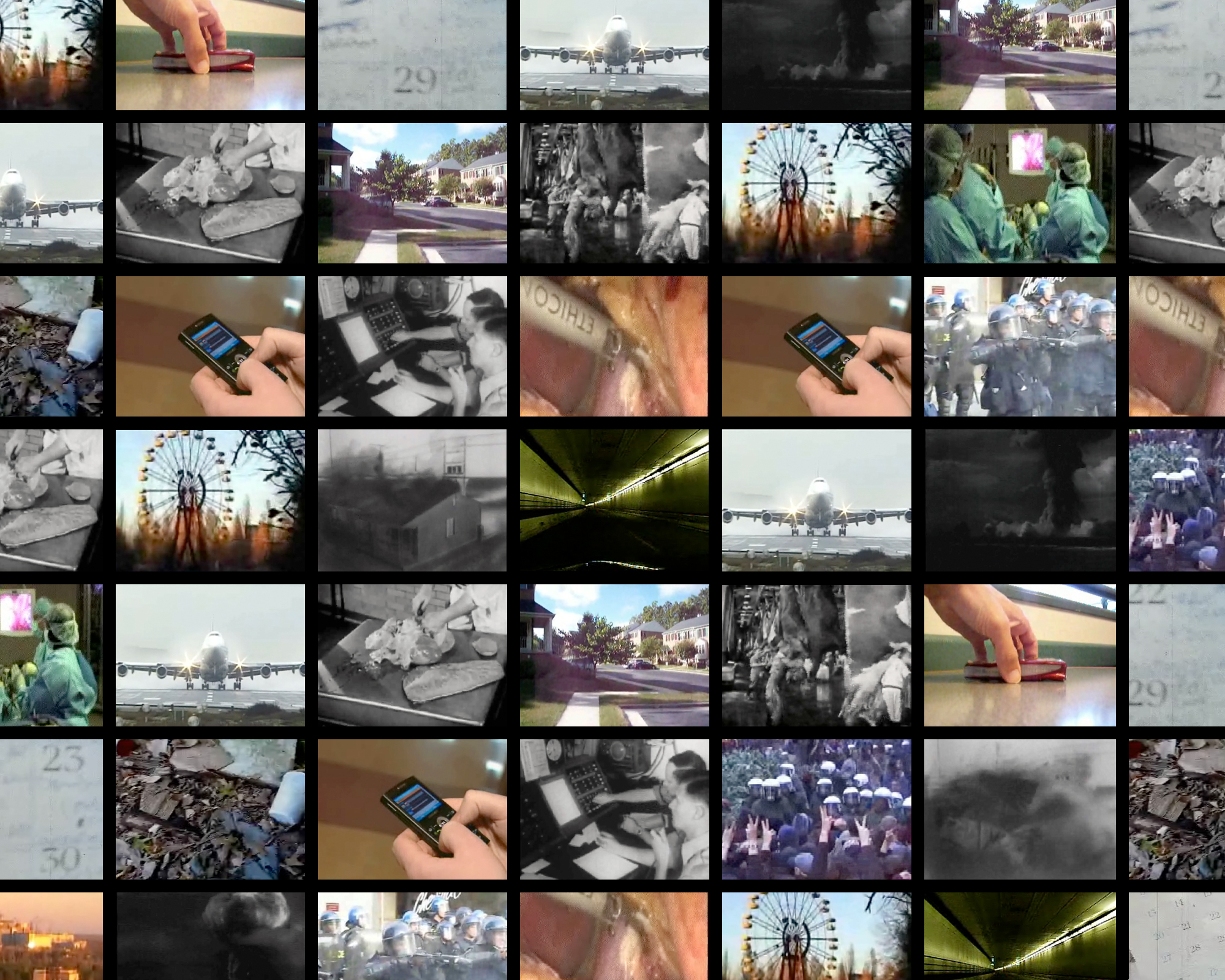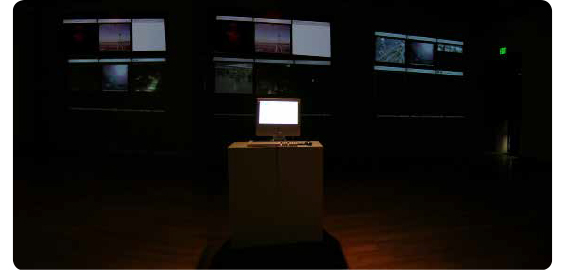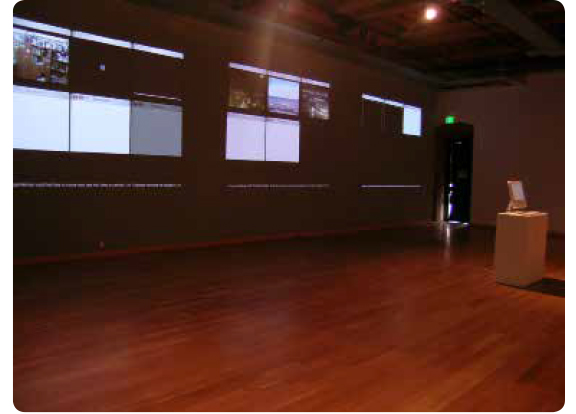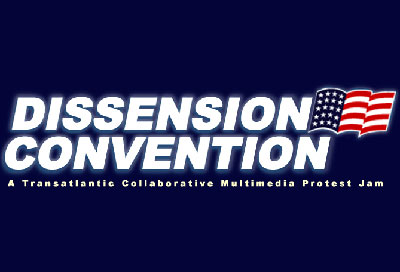Ps4. Mark Cooley. Issue 6: Fetish. Katalog
State of Art – A Conversation with G.H. Hovagimyan
State of Art – A Conversation with G.H. Hovagimyan. Mark Cooley, G.H. Hovagimyan. Furtherfield.org & Rhizome.org
(Dis)Location, (Dis)Connection, (Dis)Embodiment

Launch project: (Dis)Location, (Dis)Connection, (Dis)Embodiment
(Dis)Location, (Dis)Connection, (Dis)Embodiment is a collective experiment in database video and random access narrative. The installation is the work of many artists, each responsible for thirty seconds of video attempting to engage with paradoxes of digital culture and 21st. century communications. The installation consists of a database containing the media contributions of each artist. A computer randomly retrieves video and audio and juxtaposes the media fragments in ten-second intervals on three projected screens and three stereo output systems. The process provides an endlessly randomized deconstruction and reconstruction of narrative and associative imagery in which meaning simultaneously forms and dissolves and the usual stabilities of conventional video are put in flux.
Project concept: Mark Cooley and Edgar Endress
Project architecture: Mark Cooley
Participating Artists:
Jacqueline Aceto, Jenifer Ashcroft, George Baker, Brigitte Balla, Sean Blackford, Said Boissiere, Bridget Borley, Juan Botero, Tara Bowen, Lindsey Burnett, Nicholas Carson, Luis Cavero, Robert Cowling, Brian Dang, Daniel Dean, Jessica Engel, Jennifer Fairfax, Jennifer Farris, Emmanuel Freeman, Jessica Gibson, Lance Gunther, Tyler Harris, Moises Herrera, Franklin Hwang, Maurice James, Andrew Ke, Arthur King, Julie Koziski, Peter Lawrence, Chongha Lee, Andrew Meinecke, Michael Merrill, Aaron Miller, Eli Mintzer, Julia Moscato, Nichole Mosher, Sarah Newdorf, Brent Nieder, Kelvin Olayinka, Adrian Peters, Jose Ruiz, Sorphea Sam, Michael Sargent, Nelly Sarkissian, Paul Sauter, Christina Schnittker, Matthew Searle, Alex Straub, Aisha Syed, Mohamed Talaat, Eric Tsai, Sean Watkins, Nestor Zerpa, Yerden Zikibayev
Dear Internet

Dear Internet
2007
project documentation
by Mark Cooley and Edgar Endress.
Connection, dislocation, fear, communication, fragmentation, collectivity, intimacy, disembodiment are all possible and often simultaneously present in our attempts to interact with others online and off. Dear Internet is an experiment in collective publishing that attempts to investigate how networked technologies become platforms for the paradoxes of social relations in digital culture.

Dear Internet began in 2006 as a kind of inversion of the security and authoring conventions of blogs and blogging. Dear Internet was set up as an unmediated publishing platform where users were urged to address the Internet directly and indulge in their deepest thoughts, feelings and fantasies with the abandonment, comfort and protection that only online anonymity can provide. Initially, letters rendered some interesting aspects of the complex relationships, or lack thereof, we have with the humans of the world. Sadly, but perhaps fittingly, contributions waned and the automated publishing platform gave way to spam. The blog is now an archive of spam email and seems to be establishing a “purely” networked identity – blissfully free from the messy and complex emotive states of humanity.
2009 update: blogger detected and removed the Dear Internet blog for violating blogger’s terms of service agreement.

The first wave of human contributions to Dear Internet were presented at MAP in 2007. Installation Notes:
- One or more webcam equipped computers are located throughout the installation space with internet browsers open.
- Through an established email account, to which installation visitors are given user id and password, participants are invited to email a letter addressed directly to The internet at: dearest_internet.user@blogger.com.
- All emails are inventoried and published at Dear Internet blog.
- Submitted letters are gathered from Dear Internet blog, remixed and randomly projected as scrolling ticker texts in the installation space.
- Accompanying scrolling texts are a series of image projections. Projections feature webcam images of letter-writing installation participants accompanied by images accessed from anonymous live IP surveillance and web cameras.
- Installation audio consists of computer reading excerpts from submitted letters while being underscored and sometimes interrupted by cinematic scores and sound effects.
Dissention Convention

Dissention Convention.
2004
Networked performance and public projection
Coinciding with the Republican Convention in New York, more than 20 international net artists and digital artists broadcast a new collaborative art-polemic with a focus on how Bush and the US Republicans negatively influence every locality around the world.
All multimedia performances were created live, online on Furtherfield’s VisitorsStudio. These were projected at Postmasters Gallery’s RNC NODE, a way-station, which served as a physical node of an ad hoc public broadcasting, a system of online, real-time protest performances and alternative news actions. All online streams were also output in local bars and projections from windows.
Participating Artists Included: Maya Kalogera, Marc Garrett and Patrick Lichty, Moport.org & Glowlab, Chris Webb, Concrete Myrth & Sim, Lewis Lacook & Alan Sondheim, Sheila Murphy, Helen Varley Jamieson, Karla Ptacek, Vicki Smith & Bea Gibson, Joseph and Donna McElroy, Neil Jenkins & Roger Mills, Digitofagia vs. Autolabs, Michael Szpakowski & Ruth Catlow, Ryan Griffis & Mark Cooley